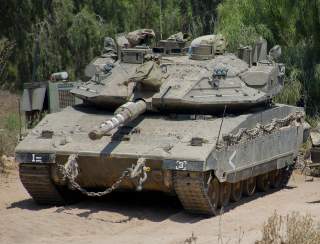This Is What It Takes to Make a Modern Main Battle Tank
We break it down.
Key point: There are several things that are needed if a tank is to be considered top-of-the-line technologically.
After a decade of relative stagnation, Western tanks are finally evolving again. A myriad of features, both new and revived from Cold War tank programs, are now being considered for inclusion in the next generation of Western tanks. But which of these might provide the greatest increases in lethality and effectiveness?
1. Active Protection Systems
While Active Protection Systems (APS) have been around since the Cold War, they were constrained to niche roles in the past. Defending against relatively slow high-explosive anti-tank (HEAT) projectiles and infantry anti-tank weapons were the typical roles for last-generation APS.
But advances in sensor and computing technology have made APS more capable. Russia’s Afghanit APS is supposedly capable of even intercepting tank rounds.
APS could fundamentally change certain aspects of tank design, as they tend to be lightweight, even compared with reactive armor systems. The old design pyramid of mobility, firepower and armoring may no longer apply when APS can act like armor by intercepting incoming projectiles, while still being relatively lightweight.
Tanks could also gain the ability to see through anti-IR smoke with APS. Since almost all APS rely on radar to detect incoming projectiles, the latest APS use the most modern radars, including special AESA radars. Due to the flexibility of AESA, said radars could be used to search for and track other tanks.
2. More Cameras
One of the greatest drawbacks of armor is limited situational awareness. While tank designers in the past used vision slits, cupolas, and periscopes of various kinds to allow the crew to see more, these vision devices often required compromises to work with heavy armor.
The recent development and miniaturization of high-resolution surveillance cameras bypass these old restrictions. While a single digital commander sight with 360-degree range is already common equipment on most tanks, distributed cameras that provide a full range of vision with no blind spots are looking to become more common. Similar systems on the F-35 jet are called DAS (Distributed Aperture System).
An upgrade to the Israeli Merkava is said to blend such a system with augmented reality technology, allowing crewmen inside the tank to have far better situational awareness than they would have ten years ago. The urban combat upgrade program for the Challenger 2 also incorporated similar camera positioning, albeit with the augmented reality.
3. Smart Ammunition
Miniaturization and the mass production of electronics and sensors have also made their way into ammunition. Digitally programmable ammunition is looking to become the new standard, with the M1A2C upgrade putting contacts on its breech face to interface with the M829A4 “smart” armor piercing round.
Russian systems focus on the other end of the projectile, with the Ainet airburst system programming a digital fuze on HE-FRAG rounds remotely.
Other innovations in this field include the German AHEAD ammunition, which splits into hundreds of little pieces of shrapnel at a programmable delay. While currently only used for air defense, such ammunition could be used to counter the distributed camera systems and radar systems used for APS on future tanks.
4. Autoloaders
Autoloaders have been around forever. While the East has largely embraced autoloaders; every frontline Russian or Soviet tank being equipped with the once since the 1970s, the West has largely stuck to using human loaders.
But the demand for a bigger and bigger gun may finally kill the human loader. While humans are able to reach great levels of efficiency and speed with current 120mm gun calibers, autoloaders outpace humans with larger calibers like the proposed 140 or 152mm tank guns.
Western resistance to autoloaders comes mostly from the utility a fourth member of a tank crew can bring in situational awareness and maintenance.
5. UAVs
However, the introduction of UAVs may allow the West to retain the fourth crew member in a useful capacity inside the tank. UAVs, like distributed cameras, could massively boost the situational awareness of a tank by providing them with an eye in the sky that could track the movement of hostiles around the tank or scout ahead for enemy armor.
Retaining a fourth member to manage such vehicles (and potentially use AR to watch the surroundings of the tank with similar interfaces) could prove a significant edge on the battlefield.
Charlie Gao studied political and computer science at Grinnell College and is a frequent commentator on defense and national-security issues. This first appeared in January 2019.

